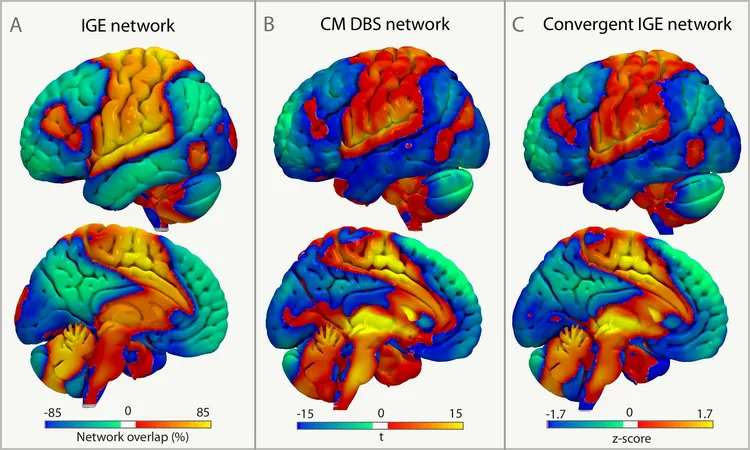
Revolutionary Brain Mapping Unveils New Pathways to Combat Generalized Seizures!
2025-03-24
Author: Arjun
Understanding Generalized Epilepsy
In a groundbreaking study, scientists have made significant strides in understanding generalized epilepsy, traditionally viewed as affecting the 'whole brain.' Contrary to this age-old belief, new research indicates that by precisely targeting specific regions of the brain with deep brain stimulation (DBS), doctors can effectively reduce generalized seizures. This advancement marks a pivotal moment in the treatment of epilepsy, a condition that has affected millions worldwide.
The Complexity of Generalized Epilepsy
Generalized epilepsy is increasingly understood as a complex brain network disorder, but identifying the precise locations of this network and its clinical significance has remained a mystery—until now. Spearheaded by Dr. Frederic L.W.V.J. Schaper, MD, Ph.D., from the Center for Brain Circuit Therapeutics at Brigham and Women’s Hospital and Harvard Medical School, a team of researchers has unveiled critical insights that challenge conventional thinking.
New Insights from Research
Their findings, published in the esteemed journal Nature Communications, reveal that generalized epilepsy networks might be mapped through the locations of subtle brain abnormalities, combined with the effects of DBS. This surgical intervention offers hope for patients battling severe generalized seizures that traditional antiseizure medications have failed to manage.
The Disconnect in Clinical Observations
Curiously, there is a growing disconnect between clinical observations and imaging research. Clinicians have often reported that brain MRIs for those with idiopathic generalized epilepsy appear 'normal.' However, larger brain imaging studies expose subtle abnormalities when these patients' scans are compared to healthy individuals. These brain irregularities, referred to as cortical atrophy, were typically dismissed as benign but now appear to hold vital clues regarding seizure origins and pathways in the brain.
Emerging Patterns in Brain Abnormalities
Initially, the locations of these abnormalities seemed arbitrary and confounding. Yet, after an extensive review of the existing literature, researchers began to see a coherent pattern emerge. This led them to explore the provocative question: could these abnormalities align with a functioning brain network?
Mapping Cortical Atrophy
Employing sophisticated methods devised at their research center, the team mapped these cortical atrophy locations to a comprehensive 'wiring diagram' of the human brain, known as the connectome. Their analysis revealed that these slight brain abnormalities cluster within a common network, which seems to be manipulated during generalized seizures.
Serendipitous Discovery in DBS Treatment
A serendipitous discovery occurred when the team found that a peak of this network corresponds directly to the area where neurosurgeons place DBS electrodes—the centromedian thalamus. This surprising correlation could elucidate why DBS treatment is successful for alleviating seizures in some patients.
Looking Ahead: Future Implications
This innovative research paves the way for refining DBS techniques and designing novel noninvasive brain stimulation therapies for generalized seizures. As the findings gain momentum, the next steps will involve rigorous clinical trials aimed at assessing the safety and efficacy of these promising brain stimulation therapies guided by the newly identified epilepsy network.
Broader Impact on Neurological Disorders
The implications of these discoveries extend far beyond the realm of epilepsy, potentially reshaping the treatment landscape for a variety of neurological disorders. As scientists continue to unravel the complexities of the brain, the future of personalized medicine in neurology seems brighter than ever!
Stay Updated!
Stay tuned for more updates as this groundbreaking study propels us closer to innovative treatments for those affected by seizures!




 Brasil (PT)
Brasil (PT)
 Canada (EN)
Canada (EN)
 Chile (ES)
Chile (ES)
 Česko (CS)
Česko (CS)
 대한민국 (KO)
대한민국 (KO)
 España (ES)
España (ES)
 France (FR)
France (FR)
 Hong Kong (EN)
Hong Kong (EN)
 Italia (IT)
Italia (IT)
 日本 (JA)
日本 (JA)
 Magyarország (HU)
Magyarország (HU)
 Norge (NO)
Norge (NO)
 Polska (PL)
Polska (PL)
 Schweiz (DE)
Schweiz (DE)
 Singapore (EN)
Singapore (EN)
 Sverige (SV)
Sverige (SV)
 Suomi (FI)
Suomi (FI)
 Türkiye (TR)
Türkiye (TR)
 الإمارات العربية المتحدة (AR)
الإمارات العربية المتحدة (AR)